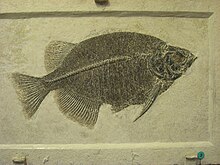Phareodus is a genus of freshwater fish from the Paleocene to the Eocene of Australia, Europe and North and South America.
| Phareodus | |
|---|---|

| |
| Phareodus testis fossil, at the Buffalo Museum of Science | |
| Scientific classification | |
| Domain: | Eukaryota |
| Kingdom: | Animalia |
| Phylum: | Chordata |
| Class: | Actinopterygii |
| Order: | Osteoglossiformes |
| Family: | Osteoglossidae |
| Subfamily: | †Phareodontinae |
| Genus: | †Phareodus Leidy, 1873 |
| Type species | |
| Phareodus encaustus Cope, 1871 | |
| Other species | |
| |
| Synonyms | |
|
Dapedoglossus[1] | |
This genus includes at least four species,[2] P. testis (Leidy, 1873) and P. encaustus of North America, P. muelleri of Europe, and P. queenslandicus of Australia. Representatives have been found in the middle Eocene of Australia, Europe and North America, including the Green River Formation in Wyoming, United States.[1] Fossils of the genus have also been found in the Paleocene (Tiupampan) Santa Lucía Formation of Bolivia.
P. testis was a freshwater fish with an oval outline, a small head, and a slightly pointed snout. Its dorsal and anal fins were situated posteriorly, with the anal fin being larger. Its caudal fin was slightly forked. It had small pelvic fins but long, narrow pectoral fins.[1]

See also
editReferences
edit- ^ a b c Frickhinger, Karl Albert (1995). Fossil Atlas: Fishes. Trans. Dr. R.P.S. Jefferies. Blacksburg, Virginia: Tetra Press.
- ^ Li et al.1997 "The species of †Phareodus (Teleostei: Osteoglossidae) from the Eocene of North America and their phylogenetic relationships." Journal of Vertebrate Paleontology 17(3):487-505